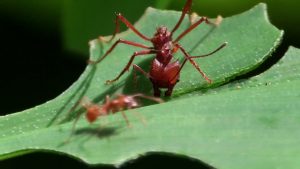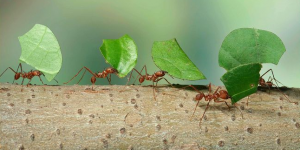 You definitely must have read about woodcutters, but have you heard of leaf-cutter ants?!
You definitely must have read about woodcutters, but have you heard of leaf-cutter ants?!
Yes, leaf cutter ants!
They are known to cut down the leaves of the trees and carry those along to their nest. Interesting, aren’t they?!
Here’s more about them.
There are 47 species of leafcutter ants. Leafcutter ants are fairly large ants and are reddish-brown in color. They have small spines on their backs.
Like all insects, a leafcutter ant’s body comprises three main parts: head, thorax, and abdomen. The head is where the mouth and sensory organs are found, the thorax is where the legs and wings are joined, and the abdomen houses the digestive and reproductive organs.
Leafcutter ants have two long antennae, and five eyes: two big, compound eyes on either side of their heads, and three simple eyes on the tops of their heads.
While it might seem like they’re vegetarians creating a massive salad bar inside their nests, they’re actually collecting those leaves to feed to their fungus gardens. It’s the fungus they grow from the decomposing leaves that’s their food. Yes, they need the leaves, but only in the way that we need fertilizer to grow our crops.
Leafcutter ant’s social structure is extremely complex with multiple chambers and passages. Leafcutter ant’s colonies can be up to 10 million ants strong, and they need space for all those ants plus their fungus gardens, nurseries, trash chambers and other chambers within their nest. Nests can be from 30m2 to 35m2 in the area, and several meters deep, with up to 8,000 chambers and tunnels 70m long, depending on the species. The nest’s chambers are built at depths that provide a suitable temperature for their intended use.
 Leafcutter ants are incredible workers, and it’s no wonder they’re considered a major crop pest. They are able to strip a tree of its foliage in less than 24 hours. And studies show that more than 17 percent of leaf production by plants surrounding a leaf-cutter ant colony goes straight into that big, fungus-growing nest. Each ant has a role to play in the colony such as workers and soldiers, and their size and physical appearance reflect what their job is within the colony. But a surprising role is that of a tiny protector. There are ants whose job it is to protect leaves from parasitic flies and wasps. These ants, called minim ants, ride on the leaves and pluck off any parasites that could cause disease or destruction if the parasite made its way into the ant colony.
Leafcutter ants are incredible workers, and it’s no wonder they’re considered a major crop pest. They are able to strip a tree of its foliage in less than 24 hours. And studies show that more than 17 percent of leaf production by plants surrounding a leaf-cutter ant colony goes straight into that big, fungus-growing nest. Each ant has a role to play in the colony such as workers and soldiers, and their size and physical appearance reflect what their job is within the colony. But a surprising role is that of a tiny protector. There are ants whose job it is to protect leaves from parasitic flies and wasps. These ants, called minim ants, ride on the leaves and pluck off any parasites that could cause disease or destruction if the parasite made its way into the ant colony.
The ant society actually consists of four main social levels, or ‘castes’: minims, minors, mediae, and majors. Minims, described earlier, mainly work inside the nest, tending to the fungus and ant larvae. Minors protect the foraging columns and also guard the nest. Media carry heavier loads back to the nest. Majors provide additional security when the nest is threatened. Some species of leafcutter ants remove waste material from the nest and take it to special areas; others have chambers within the nest to store waste.
When carrying loads back to the nest, minors are susceptible to attack from phorid flies. These flies are parasitic, and lay eggs on the heads of the ants. To prevent this, minims are known to ride on the larger ant’s back (or on the top of the leaf being carried), to fend off any attacks.
They are known to destruct essential trees by cutting down their leaves. Below is the evidence of the same:
Biggest colony of leafcutter ants in Britain has self-destructed – after they chewed through an electric power cable in their tank
By Sophie Jane Evans – Daily Mail Published: 22 May 2014
Britain’s biggest colony of leafcutter ants has self-destructed after chewing through a power cable in its tank.
More than a million of the tropical insects – who can carry 20 times their weight in their jaws – had been living at Butterfly World near St Albans, Hertfordshire.
They were dominated by a giant queen ant, the size of a small mouse, who was protected by an inner circle of soldier ants.
But in recent weeks, some of the ants had started nibbling on a power lead in their glass cabinet, which was linked to a water tank regulating their temperature.
C Tech Corporation has a solution to leaf-cutter ant’s menace.
We, at C Tech Corporation, a viable solution. The solution is named as Combirepel™. We are the sole manufacturers of the productCombirepel™.
Our company believes in the principles of sustainability and eco-balance. We do not want to imbalance the cycle of life; thereforeCombirepel™ can be easily described as insect aversive, used also against all types of insects and which works on the mechanism of repellency. It means that it does not kill the target insects but only repels them, thus balancing the ecology and helping in maintaining the goal of sustainability.
The product available in the form of masterbatch can be incorporated into the polymeric applications like the agricultural films and mulches, tree guards, and other horticultural equipment.
The liquid concentrate can be mixed in paints in a pre-determined ratio and can be applied on the concrete fences around trees.
The product available in the form of lacquer can be applied to the trunks of the trees. The lacquer can be used on already installed polymeric tree guards.
Combirepel™ is thermally stable and does not degrade on exposure to heat and sunlight. It does not kill or harm the insect but repels them. It does not volatilize and does not degrade the soil. It is RoHS, RoHS2, ISO, REACH, APVMA, NEA compliant and FIFRA exempted.
Contact us at technical.marketing@ctechcorporation.com to keep the pests away.
Also, visit our websites:
http://www.ctechcorporation.com/
http://www.rodrepel.com/
http://www.termirepel.com/
http://www.combirepel.com/
Follow our Facebook pages at:
1] https://www.facebook.com/Combirepel-411710912249274/
2] https://www.facebook.com/Termirepel-104225413091251/
3] https://www.facebook.com/Rodrepel-120734974768048/
Follow us on our Twitter pages at:
1] https://twitter.com/rodrepel
2] https://twitter.com/termirepel
3] https://twitter.com/combirepel
